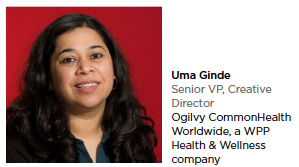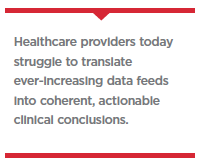 Bar chart, pie chart, line graph, Kaplan-Meier… we’ve all been there and done that. In today’s information-saturated, time-challenged environment, while the tried and tested ways still have their place, it’s time for our data presentations to catch up to the needs of those who we hope will consume them.
Bar chart, pie chart, line graph, Kaplan-Meier… we’ve all been there and done that. In today’s information-saturated, time-challenged environment, while the tried and tested ways still have their place, it’s time for our data presentations to catch up to the needs of those who we hope will consume them.
In a fast-paced data drive-by, comprehension is the first casualty. For example: “Of the 500 patients in the study, 372 were evaluable, of whom 18% agreed to participate in a 1-year follow-up. In this cohort, 64% of the subjects who continued to take the treatment drug had no disease recurrence, however, 22% had moderate to severe adverse events."
Decoding the core conclusion from a single data-clogged statement like that is hard enough. Now consider being faced with scores of such statements in the course of a single day, and sometimes in the course of a single decision, multiple times a day.
Data Bombardment
All of us are constantly being bombarded with facts, figures, statistics — physicians and healthcare decision makers are no exception. And they are expected to integrate unprecedented amounts of data into their clinical decisions, which in many cases could truly be a matter of life or death for their patients. It’s no wonder that physicians are in a tight spot: while 95% of them indicated that it is important to understand all of the statistics they encounter, a whopping 75% indicated that they could not do so.1
As a result, the old rules of data presentation must be replaced with inspired data visualization and visual storytelling that bolsters clinical information with context and conclusions. In speaking with various stakeholders in the healthcare arena, it is clear that data that fails to connect the dots for audiences fails to drive decisions.
Data is now heard on a treadmill, seen on a tiny screen, and shared on social media.
Medical communications are becoming increasingly sophisticated and strategic in their bid to bring complex, and potentially confusing, data to increasingly diverse audiences.
The multidisciplinary and multitasking opinion makers of today come not only from the hallowed halls of teaching hospitals, but also from patient advocacy groups, the  C-suite, local pharmacies, and motivated patients. Every one of these diverse audiences is looking for data that is presented in a way that makes it relevant to their needs, and can be easily consumed, not just from an article in a peer-reviewed journal, but also from websites, blog posts, virtual meetings, and Twitter feeds.
C-suite, local pharmacies, and motivated patients. Every one of these diverse audiences is looking for data that is presented in a way that makes it relevant to their needs, and can be easily consumed, not just from an article in a peer-reviewed journal, but also from websites, blog posts, virtual meetings, and Twitter feeds.
In fact, not only do audiences absorb data from multiple channels, they even absorb it simultaneously from multiple channels. An oncologist enjoying a well-deserved cup of tea and watching network television may well be exposed to the information on a new treatment in that medium. Having seen it, he might reach for his iPad and look up the website for that product. And having looked up the details of that data on the website, he may be impressed enough to share it, via tweet, post, or even old-fashioned e-mail. Not presenting data in a compelling way can represent a missed opportunity on all these engagements.
Creating a Self-Guided Discovery Strategy
Keeping these consumption patterns in mind, it is imperative for information to be supplied in a format that supports self-guided discovery. This is important both from a content as well as presentation perspective. Infographics are a viable, and valuable, tool that allow the dissemination of data-stories, and indeed, information-stories, in a way that helps guide the audience through a complex set of facts in a logical, intuitive manner. As a matter of fact, infographics are at their best when they are deployed to convey large sets of facts and figures, and engaged to build a compelling, memorable story from sometimes rather disconnected pieces of information. However, while the information in an infographic can be complex, it should on no account be confusing.
The intent is to present data in a way that simplifies the journey of the audience in bringing facts to fruition, in a succinct, cohesive way.
And then, there is the variety of audiences to take into account. A data set presentation must engage multidisciplinary audiences ranging from specialists to patients, and everyone in between, who are looking for faster, smarter, and easier ways to understand and consume clinical data. Information that is compelling to a rheumatologist may be irrelevant to a patient advocate. And what drives a patient to request a particular treatment may have very little relevance to a payer. So, a single data set may have to be leveraged differently in order for it to have relevance to different audiences. For example, data about the incidence of stroke in a certain subset of people suffering from Type 2 diabetes could be presented differently, to drive different conclusions, for a healthcare provider — “You need to pay more attention to this particular subset of patients"; a patient — “You are at risk!"; or a payer — “This subpopulation needs more educational support from their healthcare providers". The more relevant the information, the more likely it is to drive the change that is sought.
Data Optimization and Interactivity
Data that are optimized by visualization, interactivity, and memorable experiences help audiences absorb the data, and drive behavior change.
When it comes to creating context and conclusions, a picture is often worth a thousand data points. Data visualization distills large amounts of information into “snackable" visuals that can quickly and powerfully convey an idea or a conclusion.
Not only does a pictorial depiction help make a data set more comprehensible, it also allows a quick communication of the context — Who? Where? When? — and the conclusion — What does that mean?. Additionally, data visualization can focus on specific aspects of the data set, allowing the conclusion to be tailored to the particular needs of a certain audience — What does this data mean for me?
Interactivity is yet another way to enhance data absorption. When dealing with large data sets, we now have many ways to make data experience far more engaging, manageable, understandable, and customizable. From touch screens and games that help audiences navigate different aspects of information to virtual reality experiences that allow for literal “deep dives" into complex data sets, technology offers exciting new ways to engage and educate. At a convention, an interactive poster bolstered by interactive touch technology or by augmented reality can help break through the cluttered floor and convey its conclusions more succinctly, and successfully.
Bringing Data to Life
And what if data was no longer just a series of numbers and percentages, but was supported by an experience that brought it to life? An experience that allows users to “feel" the 30% more flexibility that arthritis patients might experience in their hands with a certain treatment is far more powerful, memorable, and meaningful than a statement that says the same. Real-world patient data generated in real time by devices that are customized to leverage validated scales can inform, and advance, treatment decisions.
Data must be mobilized to engage quickly, communicate coherently, and travel easily.
The most effective data communication translates seamlessly across different channels, and provides “snackable content" that audiences can easily share with their peers.
Multi-channel engagement demands data presentations that leverage and optimize visual, audiovisual, interactive and immersive technology to communicate on demand whenever and wherever audiences choose to engage. Data that is presented on a printed poster at a convention may be optimized by augmented reality that allows a key investigator to appear on a tablet to explain the nuances of that data set.
A static data set may be reborn as an interactive infographic that may be viewed on a phone. Yet another data set might be transformed into a podcast presented by an expert, and consumed while driving to work. What is common to all these disparate methods is the focus on delivering data and information in a way that maximizes its chances of being consumed.
In addition to its traditional duties of informing and educating, data today must not only mobilize, but also be mobile. Across audiences, there is a tremendous appetite for sharing information that is seen as valuable over professional social networks.
Data visualization and optimization allows data to live and work in nifty little pieces of snackable content that can be shared across social networks to reach and engage exponentially large numbers of viewers. What this means is greater engagement, and a greater groundswell of awareness that can power decisions.
Data is the New Frontier
Data is no longer the preserve of dusty digests — it is the new frontier for engagement and innovation.
It is clear that data in its age-old presentations is no longer suited to the tasks it needs to perform. Yes, data in its traditional form is still the mainstay of credibility in the healthcare world, but it is patently clear that the audiences that consume it have undergone radical transformation. While this certainly presents some challenges, it presents far more by way of opportunities. Today, we don’t have to depend on a few select publications to disseminate important data. Nor do we have to limit ourselves to a few individuals to ensure that it gets to the audiences we seek.
Or be bound by traditional ecosystems to share it. New technologies are opening doors to new venues for engagement. New opinion leaders are mobilizing audiences in whole new ways. And newly energized audiences are seeking to evangelize their insights and thinking through new channels that allow them to change behavior in a way that transforms their world, and ours.
And that, for all of us, is a conclusion worth the data it is created from.(PV)
Editor’s Note:
1. Windish DM et al. Medicine residents’ understanding of the biostatistics and results in the medical literature. JAMA. 2007;298(9):1010-1022.
Ogilvy CommonHealth Worldwide — a WPP Health & Wellness company — is committed to creativity and effectiveness in healthcare communications, everywhere.
For more information, visit ogilvychww.com.


















